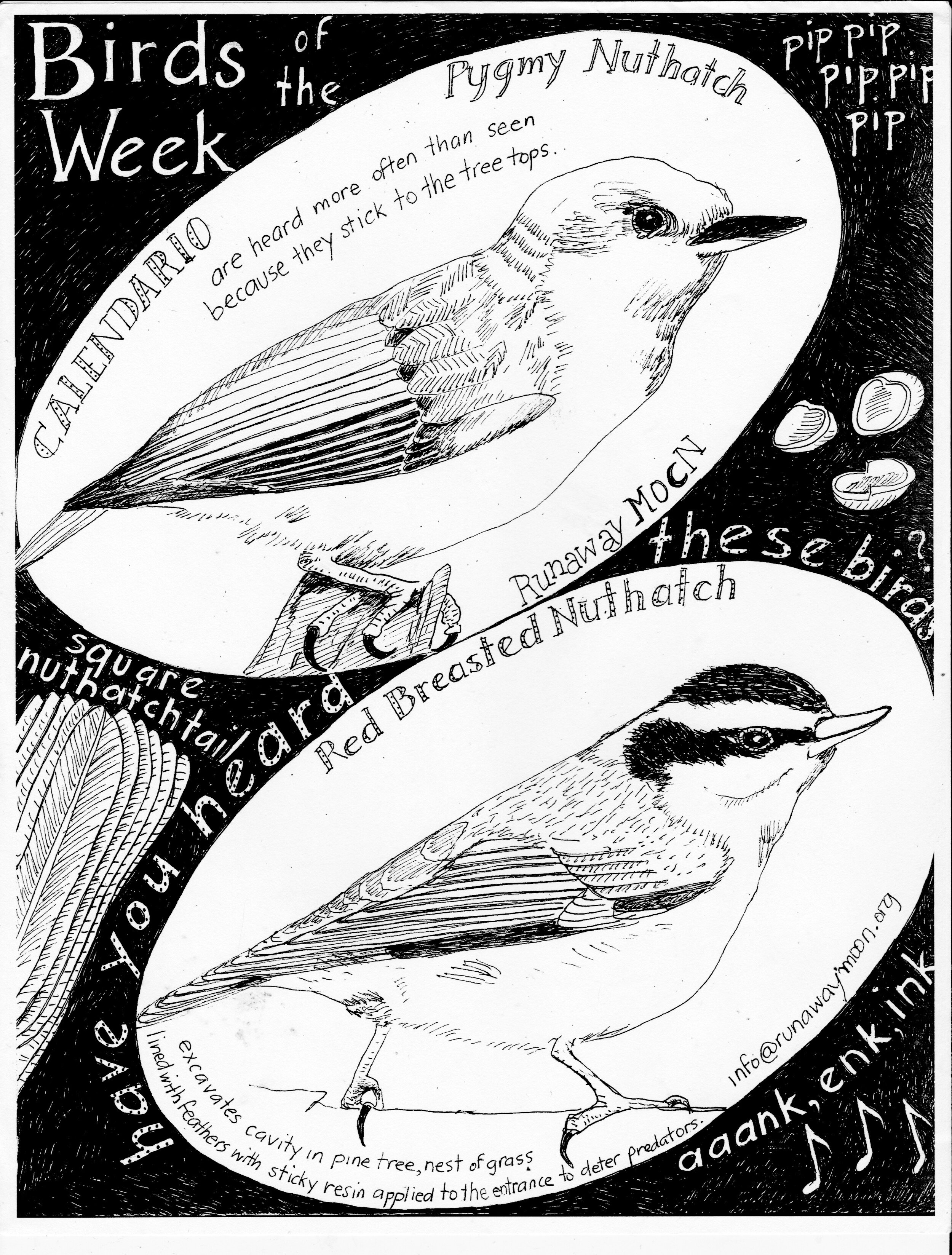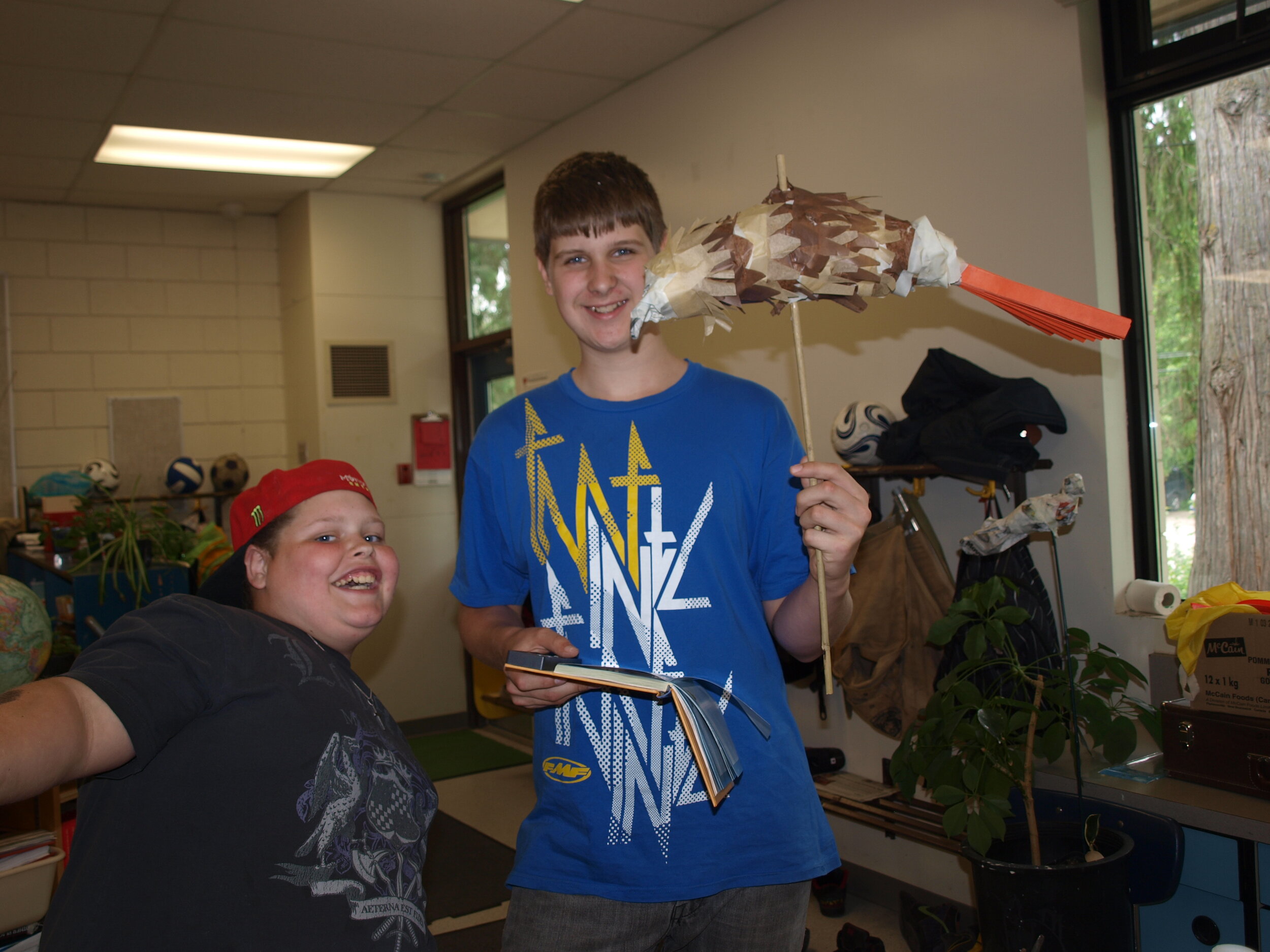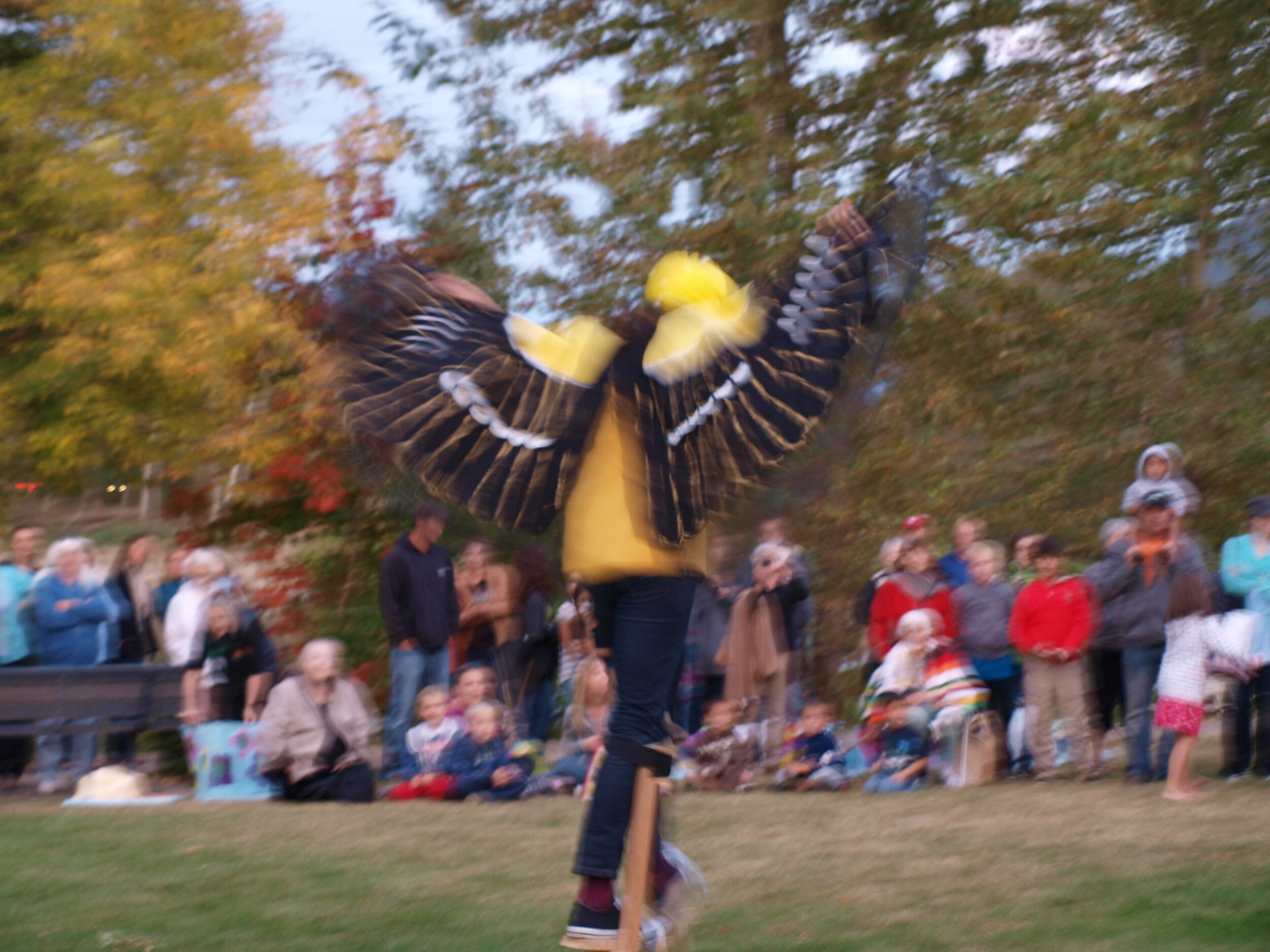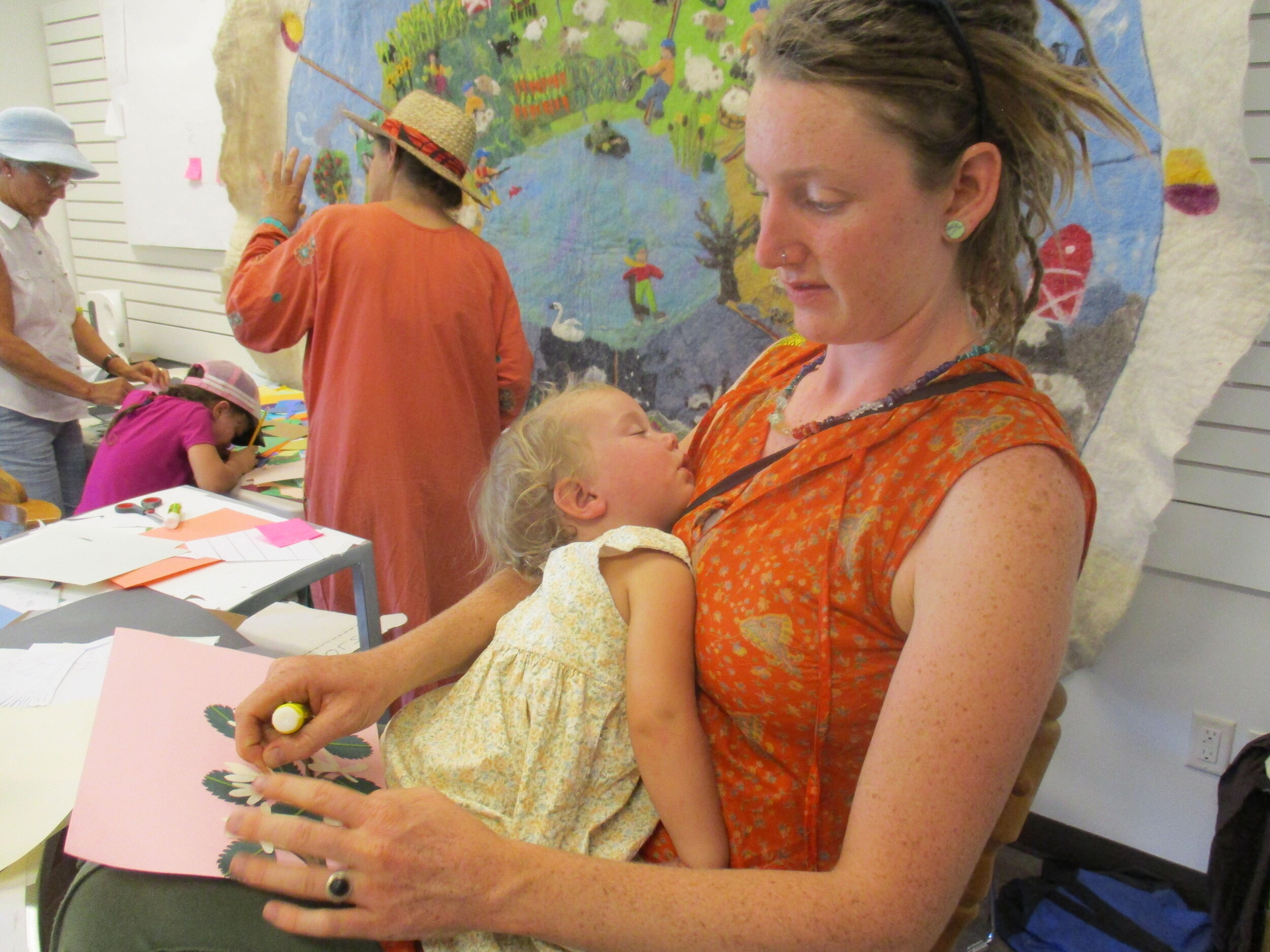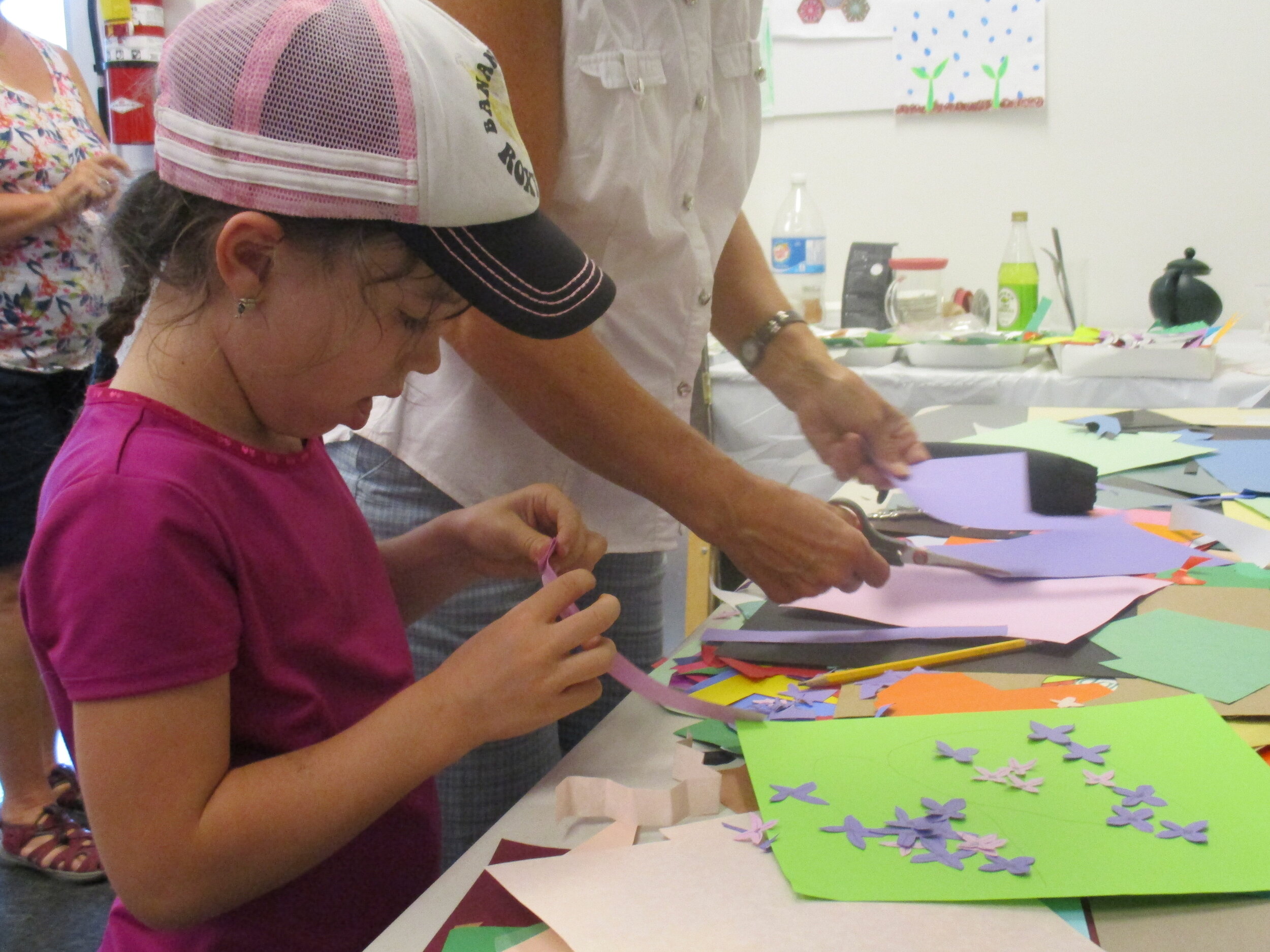
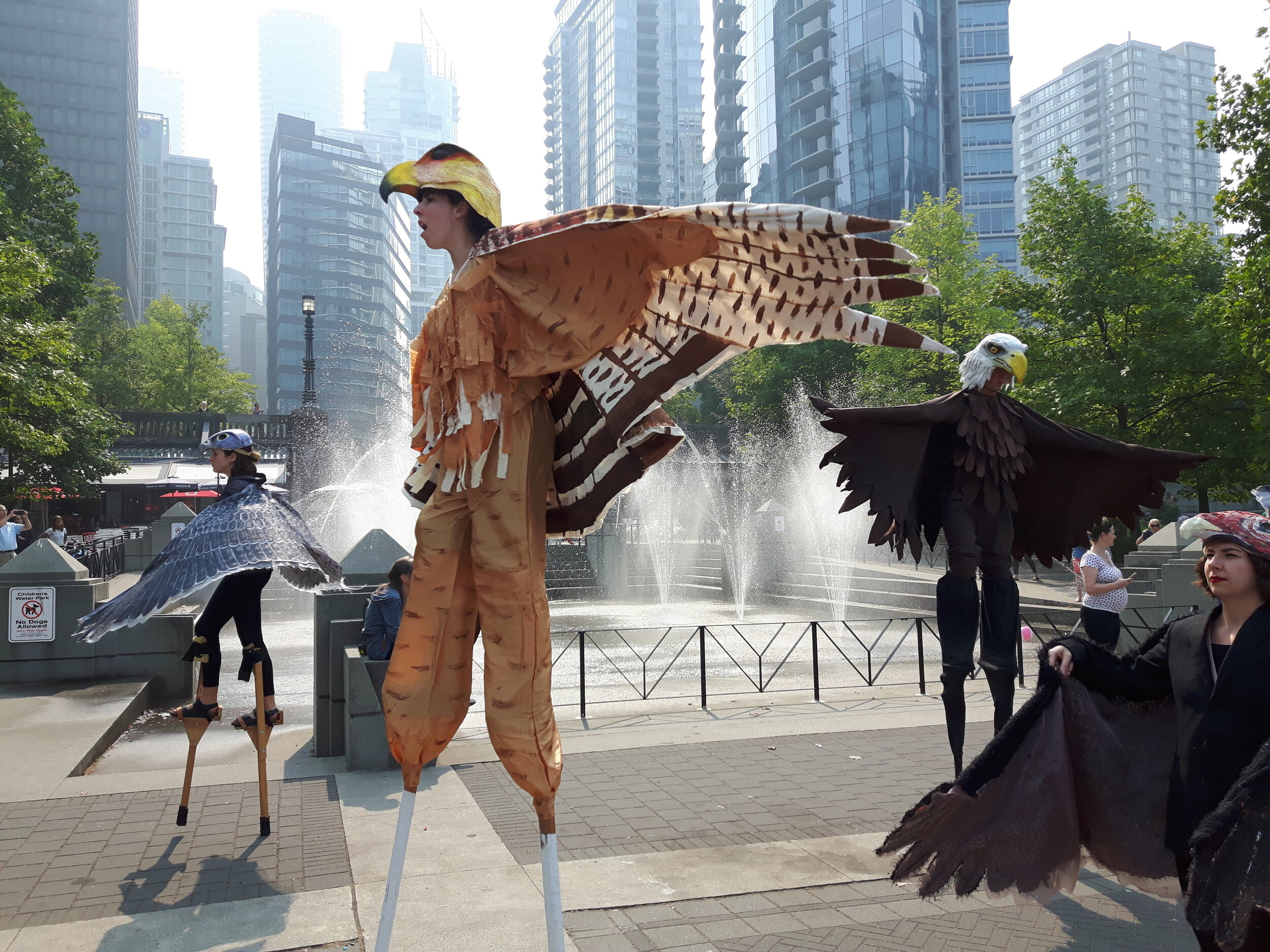

Calendario
“Calendario” is the word we use for a notion of time as cyclical, experiential, and locally-specific. Through our invitation into a variety of art projects, we have been encouraging people to take note of the sequences in nature that signal the changing of the seasons: the arrivals of birds, the blossoming of flowers, the tasks of farmers, the ripening of fruit.
Indigenous and agricultural societies use extensive knowledge of seasonal life cycle events (phenology) to predict the availability of food resources. Over a long period of time in a place, farmers develop ways to schedule tasks, based on natural indicators such as weather, night sky, and stages in the life cycles of plants and birds. Modern farmers and gardeners are likely to use calendar dates to mark when to plant and when to harvest; in temperate zones, these may not be as accurate as signs in nature, particularly in the face of unprecedented climate change.
Our Calendario project reaffirms the importance and vitality of agricultural (and other food production) knowledge and practice, through an intensive engagement with the community and the subsequent creation of a public expression of both research and experience. Just as traditional ecological knowledge is embedded in cultural practice, we have been seeking out this knowledge here, and finding multiple ways to integrate it into a local culture through participatory artmaking.
The projects have unfolded organically, based on the interest and curiosity of residents and of artists. We use “Calendario” a lens through which to see all artistic endeavours.
Mary Stockdale at Seed Swap talking about Seasonal Indicators.
Some of our Calendario-related projects:
Calendar Rug, Grindrod 2013
Salmon Arm Bay Calendar Rug, Salmon Arm 2016
Seasonal Indicators, Okanagan Landing Elementary, Vernon
Related production: “21 Ways to Make the World Last Longer” 2016-2018
Bird of the Week “Guerilla Postering” Project, Enderby 2012
In the Shade Arts Camp 2012
School Residency, M.V.Beattie School, Enderby 2013
Bird Stilt Chorus - Floating Lantern Ceremony 2012
Bird Lampposts, Enderby 2013
Raptors, with Allan Brooks Nature Centre, Vernon, 2016-17)
Birds On Parade, multi-communities culminating in Vancouver 2018
Armstrong Elementary Bees 2013
In the Shade Arts Camp
Bee Hassocks
Order of the fish
Swewllc Flags
Inspiration
This project was initially inspired by circular “Calendarios Agro-Festivos y Rituales” developed by PRATEC, an organization supporting the re-affirmation of traditional knowledge/practice in communities in the climactically diverse Andes, where people have been farming for millennia. In this photo, locally-specific murals has been painted on the wall of village schools, depicting seasons, months of the year, farming activities, ritual celebrations connected to these activities, and signs in nature that relate temporally to all of these. We wondered what a locally-specific agricultural calendar would look like, here in the South Shuswap-North Okanagan region.
We have permission and encouragement from Grimaldo Rengifo of PRATEC to adapt the concept to our region.
We are also inspired by the tradition of “The Book of Hours” agricultural calendars of medieval Northern Europe.
Duc de Berry - Book of Hours
Seasonal Indicators
My awareness of this kind of attention to knowledge was awakened through reading in “The Spirit of Regeneration” (Zed Books) by members of PRATEC, about ways on which people in the high Andes are attuned to the detailed activities of animals and plants both wild and domestic.
- Cathy Stubington
This is a list of seasonal indicators that was compiled through talking with gardeners, farmers, and local knowledge-keepers, in this area.
(See photo of Mary Stockdale talking with people at the Enderby Seed Swap.)
On the left are signs in nature, like the arrivals and departures of birds, or the blossoming of flowers, and on the right are tasks that are performed at the same time.
It is a DRAFT calendar - meaning that it is not conclusive - it invites you to test the indicators, or to find your own either by talking with people in your area or by observation. Some of them may be true regardless of being in a different spot, as they are based on the association rather than on climate or elevation. Here is a template we used to collect them.
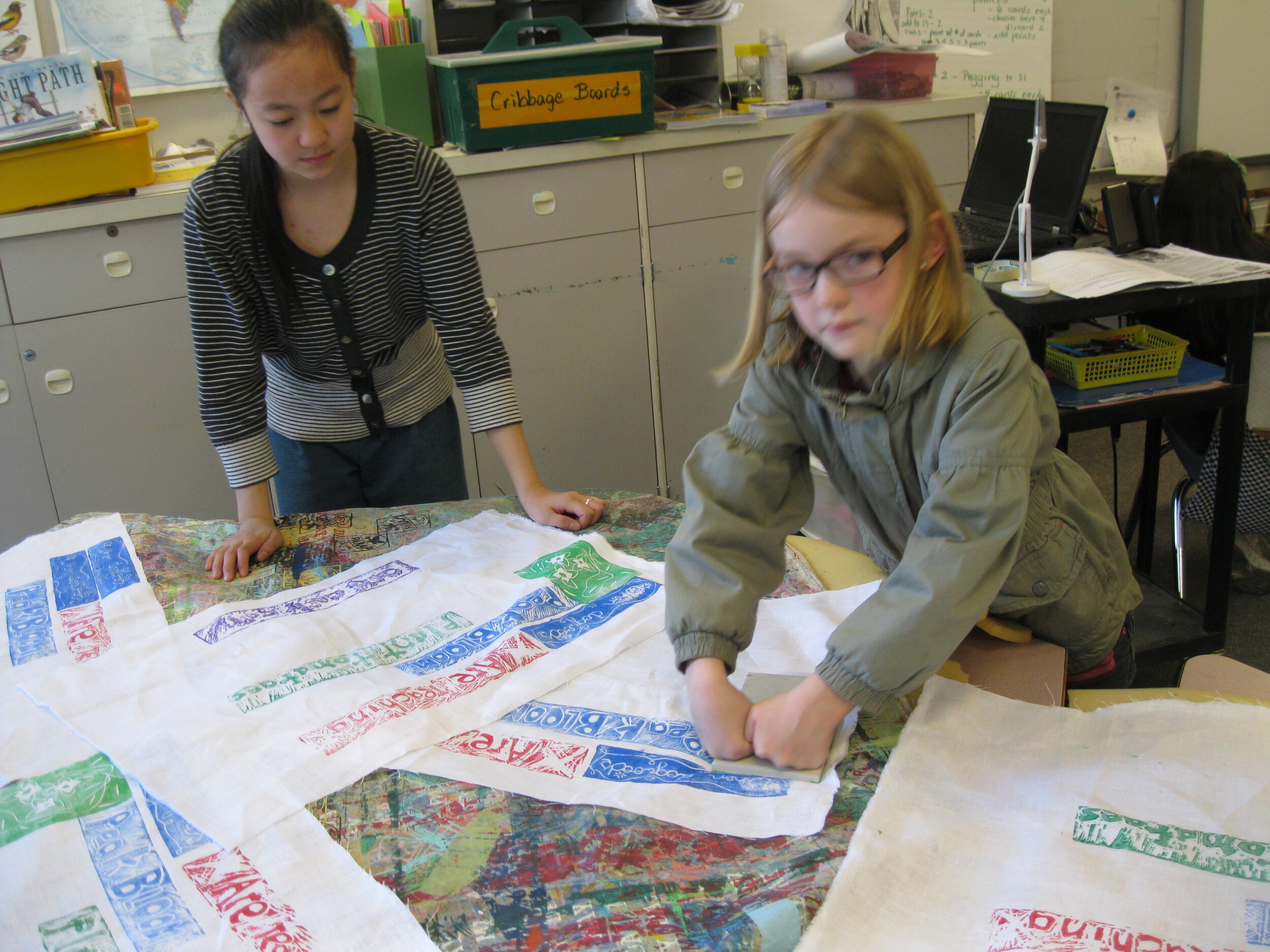
Seasonal Indicator Printmaking with Deb Humphries and Grade 3 teacher Sheila Monroe
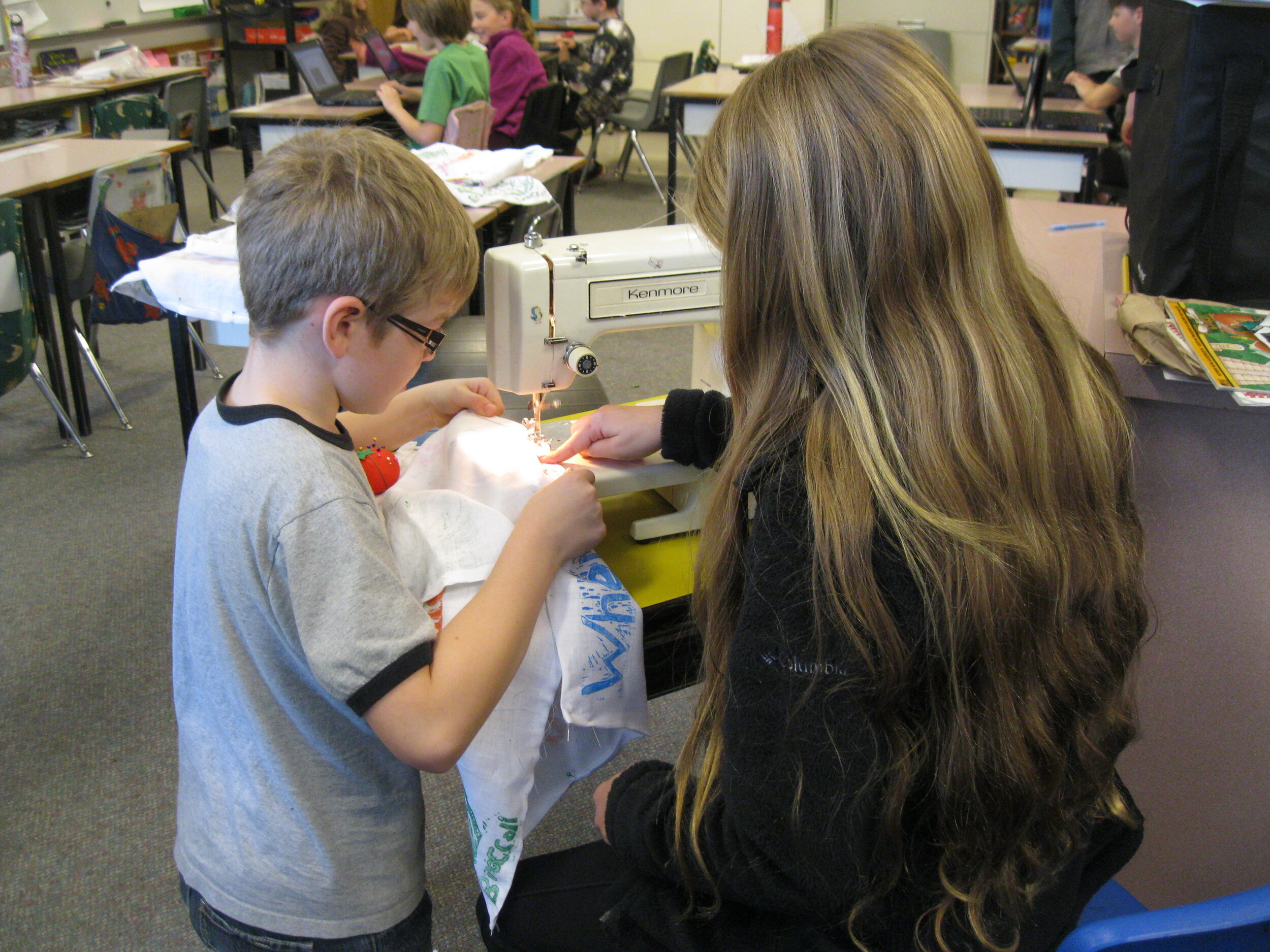

GRINDROD
Sheep Calendar Rug
2013
Farmer Gabriele Wesle and community-based artist Cathy Stubington worked with students at Grindrod Elementary, a small rural school, to create a wool felt rug depicting the Calendario of the sheeps’ lives, and how their year correlates with the lives of wild animals, plants, weather and us! Our methodology was influenced by community research methods from village calendar projects in “developing countries”.
Two classes were involved on a weekly basis: a Kindergarten / Grade 1 class, and a 5/6/7 class; all other classes participated in a final felting day.
After meeting one of Gabriele’s sheep, we put together a timeline, with input from the children: what the sheep are doing, what the farmers are doing, and what the sheeps’ food source is, over the course of a year. We figured out how to transfer a linear timeline into a cycle on a huge piece of paper. This became the plan for the felt calendar.
The background fleece was from Gabriele’s own sheep. Students helped to arrange and card coloured fleece to represent the changing sky and ground, and to make image elements for the rug.
As a celebration the classes visited Gabriele’s farm, to meet the sheep.It was time for the sheep and new lambs to go out to pasture, and everyone helped with this, and watched as the lambs discovered the grass for the first time!


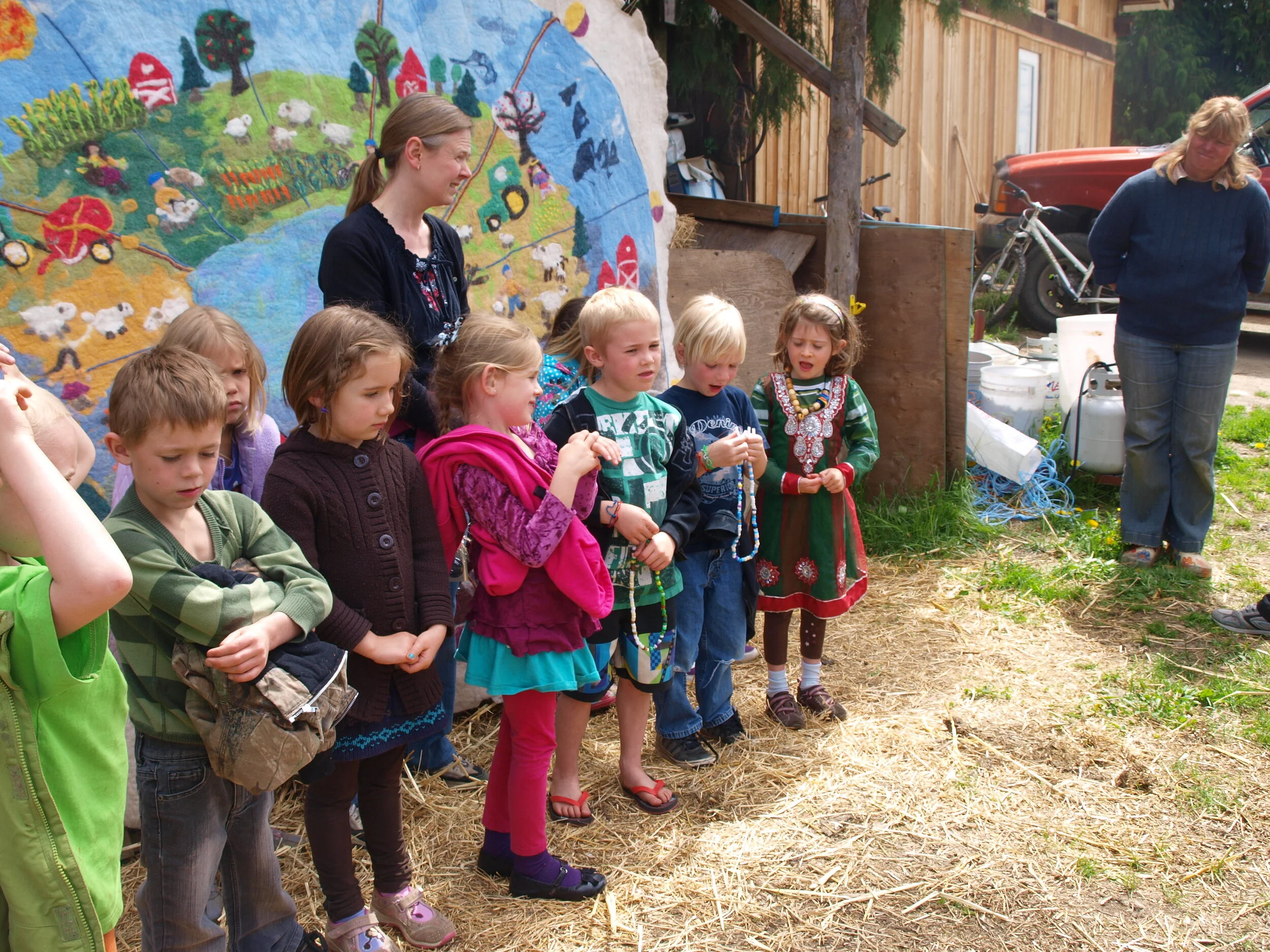


Birds
2013 - 2018
Bird of the Week Guerilla Postering (2012)
A gentleman named Tom Brighouse, who has lived in the Salmon Arm area for a long time and is familiar with the birds that come and go and stay, said he was having difficulty understanding what it was we were looking for. One day he arrived suddenly, with a stack of bird books and magazine cutouts of bird photos, and a calendar in which he had marked the name of a bird for each week of the year. I promised to make a drawing of that bird, photocopy it, and post it up all over Enderby. So that became “Bird of the Week”. Deb Humphries made bird posters in Vernon.
“In the Shade” (2012) with Kristi Christian, Teresa Christian and Cathy Stubington: We learned about local birds with a group of children and adults; each identified with a bird and made a puppet of it, everyone made a nest for their bird, and we all learned to fly. Afterward, everyone noticed more and more birds in our neighbourhood!
Bird Stilt Chorus (2012)
Eleven stilt walkers gathered, with the goal of each becoming a specific local bird identified with a recognizable mask and wings. They developed movements inspired by their birds, practiced formations based on migratory patterns, and appeared by the river for the Floating Lantern Ceremony (2012), accompanied by Popoleko choir who sang their birdsongs in call-and-response. This proved to be a wonderful way of learning a bird in an empathetic embodied manner, and on increasing awareness of the birds around us.
Grade 3 Bird Residency (2013): Teresa Christian, Julie Ross and Cathy Stubington were welcomed into Mrs. Melvin’s class at M.V. Beattie School where we learned about birds through puppets, movement, song, and group murals. Each child became expert on a bird, and shared what they knew with the whole school. The puppets were exhibited at ArtStarts Gallery in Vancouver.
Raptors (2016-17)
We collaborated with Aaron Deans of Allan Brooks Nature Centre in Vernon, to develop a chorus of Raptors (hawks, owls, eagles, etc) that are seen in that specific spot and ecosystem. Students at Vernon Community School worked on their masks and learned to walk and fly on stilts (with wings by Deb Humphries), and dancer Amanda Papillhau, with Aaron’s expertise on the birds’ movements in relation to their habitats and life cycles.
“Birds, Birds, Birds” and “Birds On Parade” (2017-18)
This flurry of activity led to a wider collaboration with a community arts residency and series of puppet drop-ins and bird stilt workshops in Vancouver, BC, and multiple other locations, culminating with “Birds On Parade” (detailed in Community Projects) opening the 27th International Ornithology Congress and the first Vancouver International Bird Festival, in August 18, 2018.
Other bird parades and school residency projects have sprung from this, in Richmond B.C. and in Revelstoke, and others ongoing, with Choreographer Isabelle Kirouac and Still Moon Arts.
Birds are a big part of seasonal indicators. They arrive and depart as the seasons change.
Like “when the swans are back on the river, start up the greenhouse” or “When the chickadee’s song changes from “chick-a-dee-dee” to “cheeseburger”, it’s time to prune raspberry canes and fruit trees”.
The project began in 2013 in which children & adults learned birds through making puppets, nests, wings, and songs. From this sprang a multi-aged stilt group in which each wore a mask and wings identifying them, and then developed movements inspired by the bird they were embodying. We practised formations, based on bird migratory patterns, and appeared in a riverside event accompanied by a choir who sang to an on behalf of them. This proved to be a wonderful way of learning a bird in an empathetic embodied manner, and on increasing awareness of the birds around us. This led to a further project in 2016-17, through Allan Brooks Nature Centre in Vernon, to develop a chorus of Raptors (hawks, owls, eagles, etc) that are seen in that specific spot and ecosystem. And then onto a residency and series of workshops in Vancouver, BC and many other locations in 2018 that culminated in the Bird Parade to open the 27th International Ornithology Congress and the first Vancouver International Bird Festival, in August 18, 2018.
Raptors at Allan Brooks Nature Centre
Raptors at Allan Brooks Nature Centre
Bird of the Week Guerilla Postering
Other Bird Activities
Bird Lampposts
Enderby, BC
Spring 2013
Inspired by our ”Bird of the Week” poster campaign, we were approached with the idea of painting the downtown lampposts in the theme of the birds, so that while walking along the sidewalk a person would be going through the natural year. Molly March and Cathy Stubington produced drawings and painted them using stencils, eventful in itself as we were constantly stopped to explain what we were doing!
Unfortunately the lampposts have since been supplanted by more modern ones.
Haikus
by Molly March and Cathy Stubington.
These haikus were composed to wind around each lamppost.
Bravest chickadees
Toughing it through coldest nights
Now sing a new song
----------------------------------------
Oh look! Robin on my lawn,
Looking for wet worms –
Why do you always bring rain?
----------------------------------------
With lengthening light,
Goldfinch transforms
Suddenly golden yellow
-------------------------
Redwing blackbirds sing
Atop the new tall cattails.
fresh green leaves unfurl.
----------------------------------------
The ice is finally gone
and Great Blue heron
goes fishing for frogs and snails.
----------------------------------------
Arriving just in time,
Rufous Hummingbird
Hovers in blossoming vines.
----------------------------------------
Blown in on the first warm wind,
Clouds of swallows
Dart at the first hatched insects.
----------------------------------------
Cedar Waxwing flocks
Noisily get drunk on
Ripe mountain ash berries.
----------------------------------------
As shadows lengthen
Canada Geese take a ride
On a cold north wind.
----------------------------------------
In leafless woods
Flicker pecks on the ground
Insects are harder to find!
Bees
Blossoming of Bee Flowers
Several Armstrong area beekeepers responded to our questions about Calendario with interest. Dianne Wells of Wild Mountain Honey invited other beekeepers to get together and compile a list of the flowers that the bees go to as their primary source of pollen and nectar, in the sequence in which they bloom. Diane chose the twelve most important of the flowers, and those became our bee calendar:
Pussywillow, Dandelion, Appleblossom, Saskatoon blossom, Acacia, Wild Mustard, Yellow Sweet Clover, Snowberry, White Sweet Clover, Alfalfa, Fall Aster, Goldenrod.
Plant Sources for Pollen and Nectar for the honeybee important nectar (N) and pollen (P) North Okanagan compiled by Dianne Wells, Wild Mountain Honey, in consultation with other apiarists.
(Dates vary yearly with the weather)
March 15 –April 5 snowdrops (P)
March 20 – April 5 crocus (P)
March 20 – April 20 * pussy willow (P) first Major pollen source
March 30 – April 20 poplar (Pollen)
April 1-15 apricot (P & N)
April 7 - 20 cherries (P & N)
April 7- 20 plums (P &N)
May 1 – May 20 * * dandelions (N & P) first Major Nectar source * apples (P & N)
May 15 – May 30 hawthorn (P & N)
chokecherry (P & N) * saskatoon (P & N)
chestnut tree (P & N)
oregon grape (P & N)
May 20 – May 30 * acacia (also called black locust) (P & N) * wild mustard
May 20 – June 15 cacagana arborescens (a common hedge, legume family)
June 1 – June 30 * yellow sweet clover (P & N)
hairy vetch (P & N)
purple vetch (P & N) * snowberry (P & N)
June 15 – July 15 * white sweet clover
July 1 – July 20 phacelia (P & N)
California poppy (P&N)
July 1 – Aug 30 sainfoin (P & N)
July 15 – July 30 catnip (P & N)
July 15 – Aug 15 thistles (P & N), fireweed (P & N), echinacea (P & N), lavender (P & N)
July 15 – Aug 30 squash, melons (P & N)
borage, oregano (P & N)
July 15 – Aug 30 ** alfalfa Major summer nectar source (Nectar only)
July 15 – frost bee balm (P & N)
Aug 1 – Aug 30 knapweed (P & N)
Aug 1 – frost sunflowers (P & N)
Aug 20 – frost autumn joysedum (P & N)
Sept 1 – frost fall asters (P & N)
Sept 1 – frost goldenrod (P & N)
Bees at
Armstrong Elementary
Winter 2013
Molly March, Kristi Christian and Cathy Stubington visited Mrs.Huska’s Grade 3 class at Armstrong Elementary School. Our apiarist friend Dianne Wells visited the class, bringing along a beehive, bee substances, and a couple of beekeepers’ suits.
Molly led the class in making pictures of the first ten flowers of the bee calendar, using coloured paper mosaic. The following week we made four giant flowers, and Kristi taught the “waggle dance” that the honey bees use to communicate to the hive where they have found a source of nectar and pollen. We imagined we were bees, visiting the flowers then returning to the hive and doing the waggle dance to communicate to the others which flower they had visited!
Bee Flower posters
Molly designed this series of posters using the flower pictures the Grade 3 children had made. They went up in town to make sure people noticed the blossoming events as they came.
Bee Flower Hassocks
2012
The twelve hexagonal hassocks (reflecting the structure of beehives) were decorated in drop-in felting workshops at the Armstrong library. Participants were asked to make a design based on one of the 12 flowers. Molly March adapted the designs by multiplying them into a hexagonal mandala form. At least 80 people worked on needle-felting the flower designs and others made bees, which were attached to the sides. The background of the hassocks were pre-felted by farmer Gabriele Wesle, with wool from her own sheep.
They were exhibited at the Armstrong Gallery in a Fibre Arts exhibit in November 2014, and an exhibit “Peonies, Puppets and Community Plays: the Art of Engagement” (about Runaway Moon) March 2015 at the Salmon Arm Gallery, in Enderby during the Tracks Symposium/Train of Thought Tour, in May, and in Penticton Museum’s exhibit “How do we get from Here to there? Travelling the Green Highway”. They were also borrowed by a class at Okanagan Landing School in Vernon, and at Bastion School in Salmon Arm. They are available for lending out.




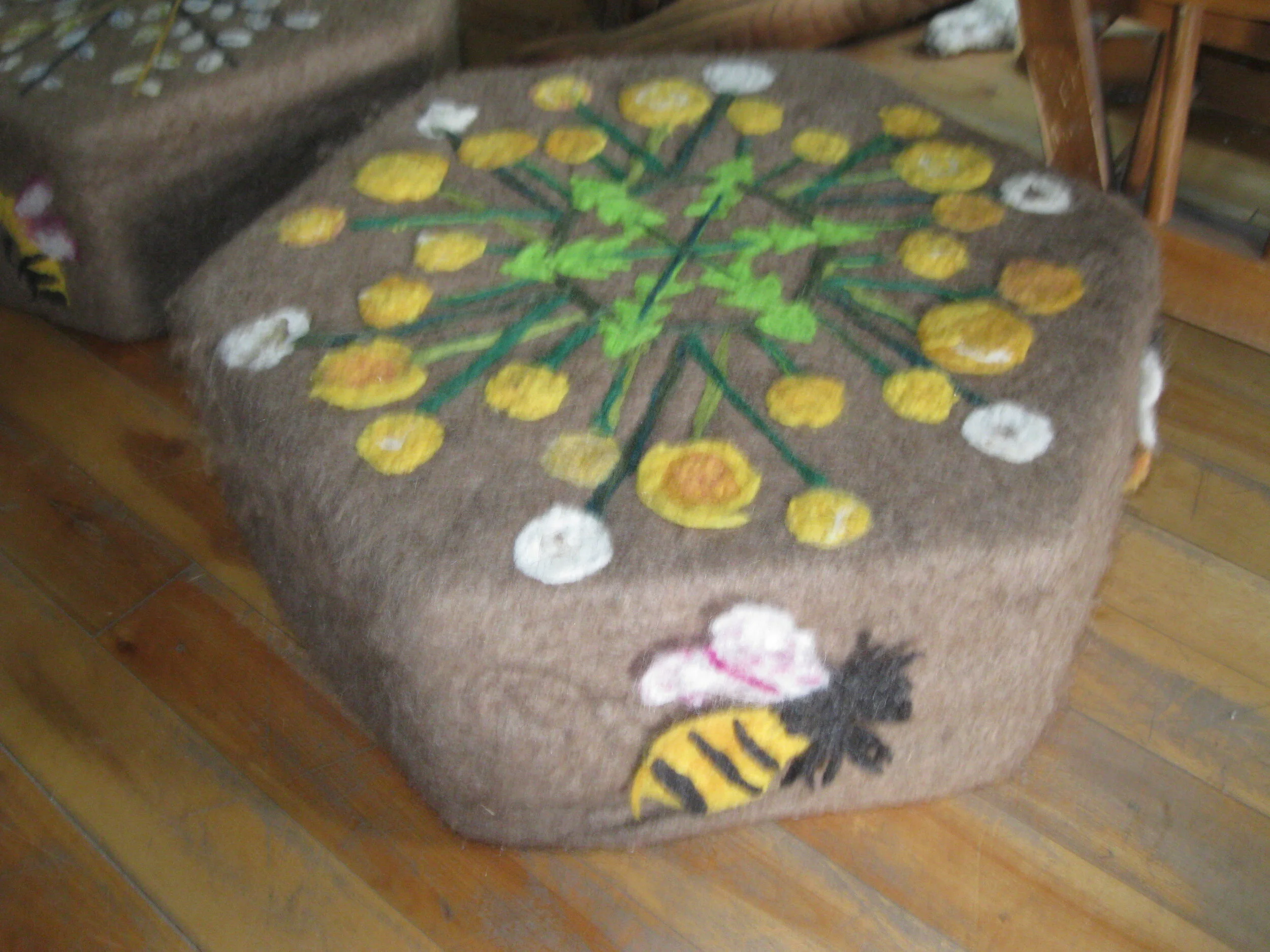


Fish
The order of the arrivals of the fish
Spring 2013
Rosalind Williams and a group of Splatsin Kia7as (grandmothers) responded the Calendario with a discussion: the order of arrival of 7 spring fish and 4 fall fish.
Using lino printing to simulate the texture of fish scales, the Grandmothers (and others) created a set of fabric fish in actual size, as teaching tools for children.
Swewllc Flags
Spring 2013
We are inspired by Buddhist Prayer Flags that live outside and blow in the wind.
With guest Secwepemc artist Tania Willard we created multiple sets of prayer flags, each with a lino print of a specific fish and its Secwepemc name. The flags are arranged in the order in which the fish arrive in this place, in spring and fall.
Community participants of all ages took part in the drop-in workshops. Both of these fish projects are a continuation of the work of the Language and Culture Programme of Splatsin Tsm7aksaltn led by Rosalind Williams, our longtime collaborator.
Calendario Wheel
We are working the final stages of a Collaborative Public Art project in Enderby.
A group of artists and farmers met for a two- day workshop in October 2014, to design potential forms for a public art piece representing Calendario., who had already been directly involved in the project :
Gabriele Wesle (farmer, community organizer), Elaine Spearing (vegetable farmer), Desiree Roell(farmer/gardener, Enderby Arts Council director), Michelle Carriere (Runaway Moon Board member and participant), Teresa Christian (gardener, traditional artist), and Jasmine Wright (young farmer, social, worker, artist).
The session was facilitated by artists Molly March and Cathy Stubington of Runaway Moon. Several interesting proposals were generated from the session, for public depictions of Calendario in Enderby.
We were most interested in a drawing reminiscent of a Tibetan or Nepalese prayer wheel, with several independently spinning wheels, each row depicts an order of natural indicators: birds, insects, trees, food plants, tools, fish, and water level/temperature. We set about designing making the elements of this. Molly made a scale model of what will be a 7 foot structure. Then with the help of local naturalists and farmers, we compiled lists of images that should be part of the Wheel.
We occupied a small space in Enderby in the summer of 2015, where community members were invited to drop in and choose what they’d like to make an image of, using small pieces of coloured paper. We pinned these up on a large plan on the wall, made to-scale of the planned rings.
After many discussions with builders including Keith Richards of Kingfisher, Sculptor Eric Kutschker of Salmon Arm is building the Calendario Wheel, Molly March is combining the images made by community members into composite designs that will be on the surface of each of 6 wheels.
Our CALENDARIO WHEEL interactive sculpture is now at the Enderby Public Library until further notice after spending May and June at the Salmon Arm Art Centre. This model, with its 6 wheels of images created by the community, is 1/2 the size of the ultimate 7 foot outdoor sculpture.
Thanks to scenic artist Molly March for finalizing the composition of images made by community members, sculptor Eric Kutschker for designing and building it, and to project producer Marcella Moser looking for a home where the full sized outdoor version of the CALENDARIO WHEEL will ultimately be installed!
Calendario Clothing
Fall and Winter 2019-20
As part of Runaway Moon’s long-term exploration finding ways to represent time, based on the cycle of events in nature, Deb Humphries, Teresa Christian, Jasmin Wright and Cathy Stubington held a series of open workshops where we encouraged/ help people to make new garments and to re-new old ones by combining pre-existing clothes with hand-printed fabric. Deb Humphries led people in printing fabric with a growing collection of carved lino blocks, with images of leaves, bugs, flowers, and other elements of nature that live here along with us.
Each new garment made through this project was both personalized and localized. In selecting images, we asked participants to consider both textures and colours, and to consider seasonal markers that are important to them and that are linked in a specific time of year. At the same time, encouraging people to make clothes this way is a way of re-using fabrics and of re-enlivening useful and essential skills. Sessions were at Vernon Library, Splatsin Community Centre, and Salmon Arm Library.
The project was put on hold, but we hope to start it up again, when Covid-19 restrictions are lifted.
Other Calendario art projects:
Cycle of Celebrations 2012
A grade 3 class made a fabric banner depicting the cycle of the seasons. In each season they applied symbols of a celebration, a special snack, a game, a sign in nature, and a task. It hangs at the end of the hallway in M.V. Beattie School.
Sunflower Picnic flags
Students at Shihaya School made fabric pictures including the elements of the Sunflower Picnic, celebrated on the side of the mountain at the special time when the Wild Sunflowers are in bloom.
Ponderosa May 2015
Is a distinctive tree resident of the land around Vernon BC. With two climate members of the Vernon Climate Action Group, Molly March and Cathy Stubington planned a banner displaying a flourishing Ponderosa pine, using block prints and stencils. A workshop took place outside “The Bean Scene” Coffee House where passers joined in and helped build the tree.
Ponderosa Banner
Cycle of Celebrations
Sunflower Picnic
Summary of
Calendario Project:
Phase 1 (June 2009 – December 2011):
- gathered phenological observations from farmers, naturalists, gardeners, traditional knowledge keepers and public-at-large in the North Okanagan/Shuswap.
- publicized our project through drop-in art sessions at events
- circulated a draft list of Seasonal Indicators.
Phase 2 (January 2012 – October 2013)
In Vernon, Armstrong, Splatsin, Enderby/Grindrod, Salmon Arm, many took part in a myriad of workshops, school residencies, mini-projects, performative events, and exhibits, which contributed to artistic and ecological research while gathering energy towards the project. The word “Calendario” is now commonly understood!
Various artists were engaged, finding how their mediums can relate to Calendario.
Ideas generated in one session folded into ideas that stimulated another:
Phase 3 (April 2014 - ongoing)
Creation of Calendario Public Art (including present project)
We will initiate the creation of art pieces in North Okanagan/Shuswap communities, so that a permanent legacy of Calendario will be portrayed in a wide an array as possible. By involving many people in the making, the knowledge becomes part of the commons. Taking into account the interests shown by participants and artists, community partners will help determine the direction that each piece will take.
Artistic Process
From Cathy Stubington:
In Calendario and other theme-based community projects that take place over a period of time, everything that comes up feeds back into the project. We start with a partial/simple plan and allow it to discover itself along the way. As lead artist for the overall Calendario project, anything I may come up with on my own is far more limited than ideas that may arise from the combined imaginations of artists and participants. People are endlessly creative and insightful.
Ideas that surface in one workshop/project are tried out in another. Everything becomes part of a final product whether it be theatrical, visual, or musical. And each “final product” feeds into the next!
For example, the PRATEC mural started the ball rolling. Ideas from its form led to a fabric Calendario about the year created in Mrs. Melvin’s Grade 3 class, and to banners in Shihaya school about the previous day up on the hillside. These helped develop the form of the Grindrod rug a few months later. In response to Calendario, the beekeepers suggested the Order of the Flowers, which led to Molly’s poster project in Mrs. Huska’s class. What we tried there moved through “In the Shade” arts camp; other ideas which emerged from “In the Shade” were tried out with a homeschool group, then back out into the community through the library Bee Calendario. (When working in classrooms both children and adults are all co-learners and teachers.)
Time is a necessary factor: “Calendario” has a presence over time, allowing for continual discovery and also broadening the understanding of what art can be. Participants are invited into very different activities, and the experience of the material is deepened and enriched. Connections between people and ideas are made as people create something meaningful together; the arts become that connection!
At the beginning of this project, the word Calendario drew blank looks and a great deal of explanation. Truly, it was more of a question we were seeking answers to. At each step, more questions arise. The art projects that emerged explain better than words can. Once the word Calendario had circulated for a while, it became part of the local vocabulary, and many people had an idea of what it is about. This process generates the sharing of knowledge and promotes curiosity and observations of the world around us, and then more questioning.
I value creative spaces in which people spend time together making something. Community art can be what we call ‘oblique activism’: people are drawn in to create something beautiful, while at the same time they have the opportunity to talk with others about their hopes and concerns. In this context, many perspectives can surface, and people can come together around important environmental or social concerns in ways they/we may have assumed impossible.
I appreciate all of these opportunities to learn about the place I live in and to deepen my own connections with all of the beings that reside here. I trust that by learning more about our non-human neighbours, we will appreciate and care for this home that we share.




































